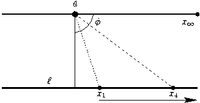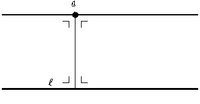توازي (هندسة)
في الهندسة الرياضية، يعبر التوازي عن علاقة ثنائية بين كائنين هندسيين مثل خطين مستقيمين أو مستويين، و تشترط هذه العلاقة استحالة التقاء هذين الكائنين في جميع نقاط الفضاء. يرمز لعملية التوازي بخطين عموديين متوازيين بالشكل ABC||DEF.
الرمز
The parallel symbol is .[1][2] For example, indicates that line AB is parallel to line CD.
In the Unicode character set, the "parallel" and "not parallel" signs have codepoints U+2225 (∥) and U+2226 (∦), respectively. In addition, U+22D5 (⋕) represents the relation "equal and parallel to".[3]
التوازي الإقليدي
خطان في مستوى
شروط التوازي
Construction
The three properties above lead to three different methods of construction[4] of parallel lines.
Distance between two parallel lines
Because parallel lines in a Euclidean plane are equidistant there is a unique distance between the two parallel lines. Given the equations of two non-vertical, non-horizontal parallel lines,
the distance between the two lines can be found by locating two points (one on each line) that lie on a common perpendicular to the parallel lines and calculating the distance between them. Since the lines have slope m, a common perpendicular would have slope −1/m and we can take the line with equation y = −x/m as a common perpendicular. Solve the linear systems
and
to get the coordinates of the points. The solutions to the linear systems are the points
and
These formulas still give the correct point coordinates even if the parallel lines are horizontal (i.e., m = 0). The distance between the points is
which reduces to
When the lines are given by the general form of the equation of a line (horizontal and vertical lines are included):
their distance can be expressed as
Two lines in three-dimensional space
Two lines in the same three-dimensional space that do not intersect need not be parallel. Only if they are in a common plane are they called parallel; otherwise they are called skew lines.
Two distinct lines l and m in three-dimensional space are parallel if and only if the distance from a point P on line m to the nearest point on line l is independent of the location of P on line m. This never holds for skew lines.
A line and a plane
A line m and a plane q in three-dimensional space, the line not lying in that plane, are parallel if and only if they do not intersect.
Equivalently, they are parallel if and only if the distance from a point P on line m to the nearest point in plane q is independent of the location of P on line m.
Two planes
Similar to the fact that parallel lines must be located in the same plane, parallel planes must be situated in the same three-dimensional space and contain no point in common.
Two distinct planes q and r are parallel if and only if the distance from a point P in plane q to the nearest point in plane r is independent of the location of P in plane q. This will never hold if the two planes are not in the same three-dimensional space.
امتداد إلى الهندسة غير الإقليدية
In non-Euclidean geometry, it is more common to talk about geodesics than (straight) lines. A geodesic is the shortest path between two points in a given geometry. In physics this may be interpreted as the path that a particle follows if no force is applied to it. In non-Euclidean geometry (elliptic or hyperbolic geometry) the three Euclidean properties mentioned above are not equivalent and only the second one,(Line m is in the same plane as line l but does not intersect l ) since it involves no measurements is useful in non-Euclidean geometries. In general geometry the three properties above give three different types of curves, equidistant curves, parallel geodesics and geodesics sharing a common perpendicular, respectively.
الهندسة الزائدية
While in Euclidean geometry two geodesics can either intersect or be parallel, in hyperbolic geometry, there are three possibilities. Two geodesics belonging to the same plane can either be:
- intersecting, if they intersect in a common point in the plane,
- parallel, if they do not intersect in the plane, but converge to a common limit point at infinity (ideal point), or
- ultra parallel, if they do not have a common limit point at infinity.
In the literature ultra parallel geodesics are often called non-intersecting. Geodesics intersecting at infinity are called limiting parallel.
As in the illustration through a point a not on line l there are two limiting parallel lines, one for each direction ideal point of line l. They separate the lines intersecting line l and those that are ultra parallel to line l.
Ultra parallel lines have single common perpendicular (ultraparallel theorem), and diverge on both sides of this common perpendicular.
الهندسة الكرية أو الناقصية

In spherical geometry, all geodesics are great circles. Great circles divide the sphere in two equal hemispheres and all great circles intersect each other. Thus, there are no parallel geodesics to a given geodesic, as all geodesics intersect. Equidistant curves on the sphere are called parallels of latitude analogous to the latitude lines on a globe. Parallels of latitude can be generated by the intersection of the sphere with a plane parallel to a plane through the center of the sphere.
انظر أيضاً
المراجع
- ^ Kersey (the elder), John (1673). Algebra. Vol. Book IV. London. p. 177.
- ^ Cajori, Florian (1993) [September 1928]. "§ 184, § 359, § 368". A History of Mathematical Notations - Notations in Elementary Mathematics. Vol. 1 (two volumes in one unaltered reprint ed.). Chicago, US: Open court publishing company. pp. 193, 402–403, 411–412. ISBN 0-486-67766-4. LCCN 93-29211. Retrieved 2019-07-22.
§359. […] ∥ for parallel occurs in Oughtred's Opuscula mathematica hactenus inedita (1677) [p. 197], a posthumous work (§ 184) […] §368. Signs for parallel lines. […] when Recorde's sign of equality won its way upon the Continent, vertical lines came to be used for parallelism. We find ∥ for "parallel" in Kersey,[14] Caswell, Jones,[15] Wilson,[16] Emerson,[17] Kambly,[18] and the writers of the last fifty years who have been already quoted in connection with other pictographs. Before about 1875 it does not occur as often […] Hall and Stevens[1] use "par[1] or ∥" for parallel […] [14] John Kersey, Algebra (London, 1673), Book IV, p. 177. [15] W. Jones, Synopsis palmarioum matheseos (London, 1706). [16] John Wilson, Trigonometry (Edinburgh, 1714), characters explained. [17] W. Emerson, Elements of Geometry (London, 1763), p. 4. [18] L. Kambly, Die Elementar-Mathematik, Part 2: Planimetrie, 43. edition (Breslau, 1876), p. 8. […] [1] H. S. Hall and F. H. Stevens, Euclid's Elements, Parts I and II (London, 1889), p. 10. […]
[1] - ^ "Mathematical Operators – Unicode Consortium" (PDF). Retrieved 2013-04-21.
- ^ Only the third is a straightedge and compass construction, the first two are infinitary processes (they require an "infinite number of steps".)
المراجع
- Heath, Thomas L. (1956), The Thirteen Books of Euclid's Elements (2nd ed. [Facsimile. Original publication: Cambridge University Press, 1925] ed.), New York: Dover Publications
- (3 vols.): ISBN 0-486-60088-2 (vol. 1), ISBN 0-486-60089-0 (vol. 2), ISBN 0-486-60090-4 (vol. 3). Heath's authoritative translation plus extensive historical research and detailed commentary throughout the text.
- Richards, Joan L. (1988), Mathematical Visions: The Pursuit of Geometry in Victorian England, Boston: Academic Press, ISBN 0-12-587445-6
- Wilson, James Maurice (1868), Elementary Geometry (1st ed.), London: Macmillan and Co.
- Wylie Jr., C. R. (1964), Foundations of Geometry, McGraw–Hill
للاستزادة
- Papadopoulos, Athanase; Théret, Guillaume (2014), La théorie des parallèles de Johann Heinrich Lambert : Présentation, traduction et commentaires, Paris: Collection Sciences dans l'histoire, Librairie Albert Blanchard, ISBN 978-2-85367-266-5




















